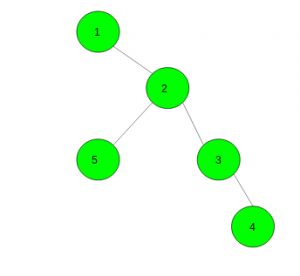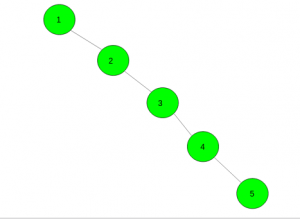给定一个整数k和一棵有n 个节点的树。任务是计算距离恰好为k的不同顶点对的数量。
例子:
Input: k = 2

Output: 4
Input: k = 3

Output: 2
方法:这个问题可以用动态规划解决。对于树的每个顶点 v,我们计算值 d[v][lev] (0 <= lev <= k)。该值表示与 v 的距离为 lev 的顶点数。注意 d[v][0] = 1。
然后我们计算答案。对于任何顶点 v,对的数量将是第 j – 1 层和第 k – j 层的顶点数量的乘积。
下面是上述方法的实现:
C++
// C++ implementation of the approach
#include
using namespace std;
#define N 5005
// To store vertices and value of k
int n, k;
vector gr[N];
// To store number vertices at a level i
int d[N][505];
// To store the final answer
int ans = 0;
// Function to add an edge between two nodes
void Add_edge(int x, int y)
{
gr[x].push_back(y);
gr[y].push_back(x);
}
// Function to find the number of distinct
// pairs of the vertices which have a distance
// of exactly k in a tree
void dfs(int v, int par)
{
// At level zero vertex itself is counted
d[v][0] = 1;
for (auto i : gr[v]) {
if (i != par) {
dfs(i, v);
// Count the pair of vertices at
// distance k
for (int j = 1; j <= k; j++)
ans += d[i][j - 1] * d[v][k - j];
// For all levels count vertices
for (int j = 1; j <= k; j++)
d[v][j] += d[i][j - 1];
}
}
}
// Driver code
int main()
{
n = 5, k = 2;
// Add edges
Add_edge(1, 2);
Add_edge(2, 3);
Add_edge(3, 4);
Add_edge(2, 5);
// Function call
dfs(1, 0);
// Required answer
cout << ans;
return 0;
} Java
// Java implementation of the approach
import java.util.*;
class GFG
{
static final int N = 5005;
// To store vertices and value of k
static int n, k;
static Vector[] gr = new Vector[N];
// To store number vertices at a level i
static int[][] d = new int[N][505];
// To store the final answer
static int ans = 0;
// Function to add an edge between two nodes
static void Add_edge(int x, int y)
{
gr[x].add(y);
gr[y].add(x);
}
// Function to find the number of distinct
// pairs of the vertices which have a distance
// of exactly k in a tree
static void dfs(int v, int par)
{
// At level zero vertex itself is counted
d[v][0] = 1;
for (Integer i : gr[v])
{
if (i != par)
{
dfs(i, v);
// Count the pair of vertices at
// distance k
for (int j = 1; j <= k; j++)
ans += d[i][j - 1] * d[v][k - j];
// For all levels count vertices
for (int j = 1; j <= k; j++)
d[v][j] += d[i][j - 1];
}
}
}
// Driver code
public static void main(String[] args)
{
n = 5;
k = 2;
for (int i = 0; i < N; i++)
gr[i] = new Vector();
// Add edges
Add_edge(1, 2);
Add_edge(2, 3);
Add_edge(3, 4);
Add_edge(2, 5);
// Function call
dfs(1, 0);
// Required answer
System.out.print(ans);
}
}
// This code is contributed by PrinciRaj1992 Python3
# Python3 implementation of the approach
N = 5005
# To store vertices and value of k
n, k = 0, 0
gr = [[] for i in range(N)]
# To store number vertices at a level i
d = [[0 for i in range(505)]
for i in range(N)]
# To store the final answer
ans = 0
# Function to add an edge between two nodes
def Add_edge(x, y):
gr[x].append(y)
gr[y].append(x)
# Function to find the number of distinct
# pairs of the vertices which have a distance
# of exactly k in a tree
def dfs(v, par):
global ans
# At level zero vertex itself is counted
d[v][0] = 1
for i in gr[v]:
if (i != par):
dfs(i, v)
# Count the pair of vertices at
# distance k
for j in range(1, k + 1):
ans += d[i][j - 1] * d[v][k - j]
# For all levels count vertices
for j in range(1, k + 1):
d[v][j] += d[i][j - 1]
# Driver code
n = 5
k = 2
# Add edges
Add_edge(1, 2)
Add_edge(2, 3)
Add_edge(3, 4)
Add_edge(2, 5)
# Function call
dfs(1, 0)
# Required answer
print(ans)
# This code is contributed by Mohit KumarC#
// C# implementation of the approach
using System;
using System.Collections.Generic;
class GFG
{
static readonly int N = 5005;
// To store vertices and value of k
static int n, k;
static List[] gr = new List[N];
// To store number vertices at a level i
static int[,] d = new int[N, 505];
// To store the readonly answer
static int ans = 0;
// Function to add an edge between two nodes
static void Add_edge(int x, int y)
{
gr[x].Add(y);
gr[y].Add(x);
}
// Function to find the number of distinct
// pairs of the vertices which have a distance
// of exactly k in a tree
static void dfs(int v, int par)
{
// At level zero vertex itself is counted
d[v, 0] = 1;
foreach (int i in gr[v])
{
if (i != par)
{
dfs(i, v);
// Count the pair of vertices at
// distance k
for (int j = 1; j <= k; j++)
ans += d[i, j - 1] * d[v, k - j];
// For all levels count vertices
for (int j = 1; j <= k; j++)
d[v, j] += d[i, j - 1];
}
}
}
// Driver code
public static void Main(String[] args)
{
n = 5;
k = 2;
for (int i = 0; i < N; i++)
gr[i] = new List();
// Add edges
Add_edge(1, 2);
Add_edge(2, 3);
Add_edge(3, 4);
Add_edge(2, 5);
// Function call
dfs(1, 0);
// Required answer
Console.Write(ans);
}
}
// This code is contributed by Rajput-Ji PHP
Javascript
输出:
4